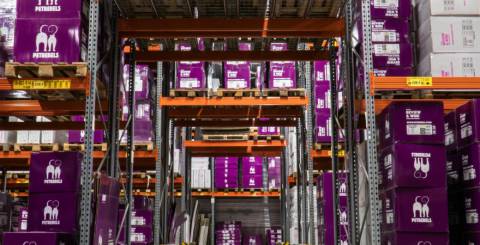The Impact of IoT on Inventory Management

For modern businesses to thrive, ensuring the effective management of inventory stands has become vitally important. Inventory management stands as a cornerstone of success. And the emergence of the Internet of Things (IoT) has introduced a new era of connectivity and efficiency across diverse industries. One domain where its transformative impact is notably evident is in the realm of inventory management. As businesses increasingly embrace IoT technologies, the traditional paradigms of tracking and managing inventory have shifted remarkably.
Connecting physical objects to the digital realm has unlocked unprecedented levels of visibility, control, and optimization in inventory processes. In this blog, we will delve into the profound impact of IoT on inventory management, exploring how smart sensors, real-time data analytics, and interconnected devices are revolutionizing how organizations handle their stock, streamline operations, and enhance overall supply chain resilience.
Suppose you are wondering what IoT has to do with inventory management. In that case, I recommend that you continue reading this article, where I will briefly cover this novel technological force's impact on inventory management.
But first, a quick primer on exactly what this phenomenon is about.
What Is Inventory Management?
In the modern context, inventory management is the systematic management and tracking of a given company's input materials and goods. Considering its role in keeping a company running, inventory management is essential to its operations. It affects the company's operational efficiency and its ability to ensure top-notch customer satisfaction and overall profitability.
As companies across the broad spectrum of industries increasingly embrace digital transformation, integrating the latest technologies has become a must. One such transformative technology is the Internet of Things (IoT).
How Can IoT Completely Transform Inventory Management?
Better supply chain visibility: Thanks to IoT, inventory management systems have now taken supply chain visibility to the next level. IoT devices, such as sensors and RFID tags, allow companies to track their real-time inventory movement: from the production factory to distribution centers and, eventually, end-users. Such improved visibility can be used by businesses to find any potential bottlenecks, quickly adapt to changes in demand, and optimize their overall supply chain processes.
Automated Tracking and Monitoring: RFID tags, GPS trackers, and other IoT devices automate inventory tracking and monitoring. This eliminates the need for manual data entry and barcode scanning, reducing human errors and improving the overall accuracy of inventory records.
Enhanced fleet inventory management: Fleet management is another essential aspect. You can rest assured that IoT has also had a massive impact in this regard. IoT-enabled solutions can be attached to vehicles in the fleet to provide teams with continuous data on the location and condition of the cars and the status of goods being transported. This, of course, helps companies optimize route planning and scheduling.
Besides that, it can help with predictive maintenance, too.
Improved quality control: Believe it or not, IoT has come to play a central role in quality control, too. How you ask. Well, for starters, the connected IoT sensors and devices can monitor environmental conditions, such as temperature, humidity, and pressure, to ensure that perishable goods are stored and transported within parameters conducive to longevity. IoT also helps companies track product lifecycle data, thus finding and rectifying quality issues quickly, if at all.
Regulatory compliance: Most industries today need to ensure compliance with many regulations, which is quite a task. It can help by delivering precise and traceable data across the supply chain.
Improved Customer Satisfaction: With accurate and real-time information about product availability, businesses can fulfill customer orders more reliably. This results in improved customer satisfaction and loyalty, as customers can trust that the products they need are in stock and can be delivered promptly.
Final Words
In summary, the incorporation of Internet of Things (IoT) technologies into inventory management has emerged as a transformative element for businesses aiming to excel in an era characterized by increased connectivity and data-driven decision-making. The implementation of intelligent sensors and interconnected devices has notably enhanced operational efficiency. However, it has also provided a level of visibility and control over previously unimaginable inventory. Real-time data analytics and predictive insights have empowered organizations to make informed decisions, anticipate demand fluctuations, and proactively address supply chain challenges.
Further, in the dynamic realm of inventory management, the interdependence of IoT and streamlined stock handling serves as evidence of the profound impact of technological advancement. As IoT capabilities continually progress, businesses are strategically poised to address the intricacies of contemporary supply chains, respond to shifting market dynamics, and ultimately gain a competitive advantage in the marketplace. The journey towards smarter, more connected inventory management has just begun, promising further advancements and opportunities for businesses willing to embrace the transformative potential of IoT.
There you have it, ladies and gentlemen — some of the many ways IoT-empowered inventory management can help companies enhance their operational efficiency while improving their overall resilience and competitiveness — no matter the industry in which they operate. No wonder more and more companies want to use IoT for inventory management.
Similar Articles
Do you know what the following e-commerce companies have in common: Amazon, Walmart, eBay, and more? All of these e-commerce companies' apps make use of Java. Java is decidedly among the leading choices of programming language for e-commerce applications because it offers a world of benefits; for example, since Java code can be run on any platform with a Java Virtual Machine (JVM), users of e-commerce apps made with Java can access the said apps on a variety of devices.
Nikola Tesla in 1926, once described what is now called a mobile phone as a telephone that can fit into one's “vest pocket.” As otherworldly as that idea was then, nearly a century later, the reality is even more astounding.
Given the staggeringly high amounts of data being generated worldwide every single day, it ought to come as no surprise that organizations often struggle to pick the right tools to help them effectively harness the potential of all their data.
Managing properties can be a difficult task with the right tools. Property owners must find and use the best property management software. It can be a long and tedious process as there are many options in the property management software market.
In the ever-evolving financial services landscape, industry challenges are numerous and complex. From stringent regulations to rapidly advancing technology and changing consumer expectations, financial institutions face many obstacles.
The human learning capability is a great resource for helping technology evolve and grow, breaking boundaries, and creating new ones. Emulating the ability of humans to learn at a gradual but retentive pace, Machine Learning is the latest power monster that is redefining human-machine interaction.
In the ever-evolving landscape of low-code development, Microsoft's Power Platform stands out as a powerful tool for building custom applications. In today's dynamic digital landscape, creating and managing web pages is no longer the exclusive realm of professional web developers
In the data-driven business world, where information is of utmost priority, organizations are increasingly turning to data warehousing and data marts to harness the power of their data. These data management solutions are pivotal in transforming raw data into actionable insights.
Organizations today deal with massive amounts of data. To make informed decisions based on such data, it is necessary to analyze the data in a way that gives insights that can be acted upon. Data flow itself can be unreliable and there are many points during their transfer from one system to another where data can be prone to corruption.









